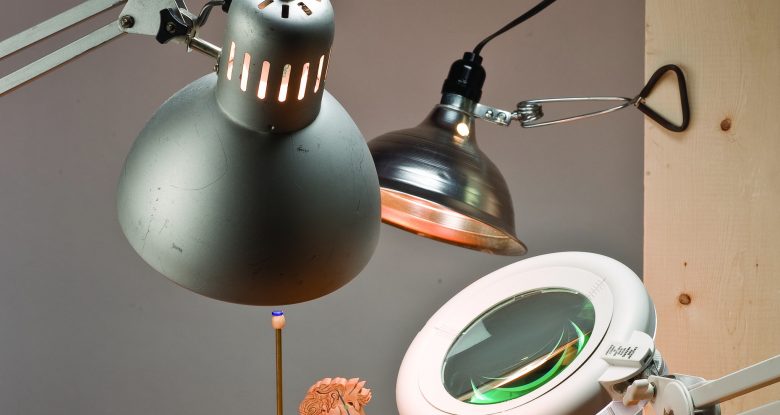Improve your scrolling experience with proper lighting
by Bob Duncan
This article was first published in issue 47 of Scroll Saw Woodworking & Crafts
Many home workshops are lit with a few hanging screw-in incandescent (or compact florescent) bulbs. Some have a few bars of traditional tube florescent lights. These can be a good starting point, but in your shop, you need several different types of light. For every aspect of scrolling, the better your lighting, the better your end result will be. Plus, more light gives you a safer working environment; not only can you see what you are doing, but you’ll avoid the eyestrain and headaches caused by working in dim light.
Fill Lighting
Fill lighting does exactly that: fills the space and chases away deep shadows. The best fill lighting is natural sunlight, which is why many art studios have big windows. If you don’t have much natural lighting—or you often work at night—install banks of tube florescent fixtures, which provide a great deal of light without consuming a lot of power.
Unfortunately, inexpensive florescent light fixtures can be finicky when the temperatures get cold. If you don’t line up the bulbs exactly in these fixtures, which are sold as shop lights and available for around $10 at most home improvement stores, the lights won’t always turn on right away. I have two lights in my shop that I occasionally need to bump before they will turn on. Mid-range fixtures, which cost around $30, are more reliable.
Sometimes you need more fill lighting in a specific area, such as around the band saw or sanding station. Incandescent fixtures are inexpensive but can be difficult to adjust so the light comes from the right angle and direction—you may need to angle the electrical box. Instead, I installed adjustable outdoor floodlight fixtures and use them with halogen bulbs. Both the fixtures and bulbs are more expensive than standard options, but I find they are easier to install and adjust, and provide more light than other choices.
Task Lighting
One of my saws has an integrated light attached directly to the saw. This fixture, on an adjustable gooseneck, allows me to position the light right on the lines I’m cutting. Position the light so the blade casts a shadow across the blank. As you cut, align the intersection of the blade and shadow with the pattern line to cut exactly on the line.
For intricate projects, I have a lighted magnifying glass. The magnifier makes it easier to cut small frets, but it does take a bit of practice to use because a slight movement looks much bigger through the magnifier.
When finishing, especially if I’m painting, I switch to a light with a daylight bulb. Incandescent, halogen, and florescent bulbs all have temperatures that can change the way a color looks. Florescent bulbs are considered cool lights and can give your piece a blue cast. Halogens and incandescents are warm lights and can give your piece a red or orange cast. Daylight bulbs are calibrated to resemble natural sunlight, which is considered white light. No artificial light can match natural sunlight exactly, but daylight bulbs come close. You can find compact florescent bulbs, spotlights, and regular incandescent bulbs calibrated as daylight bulbs.
When I use a clear finish, I position a light to shine across the surface of the wood. The finished and unfinished wood pick up the light differently, so I can see at a glance which areas need more attention.
When planning lighting for your shop, err on the side of too much light. You’ll enjoy the scrolling experience more if you can see what you are doing and work without a headache or injury.
Discuss this material on the Scroll Saw Woodworking & Crafts forums.







